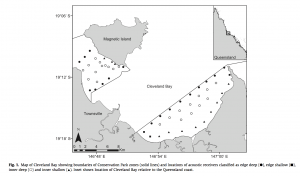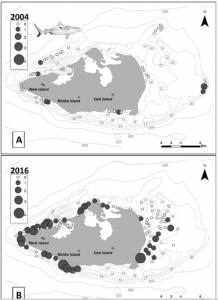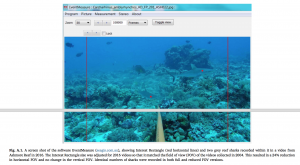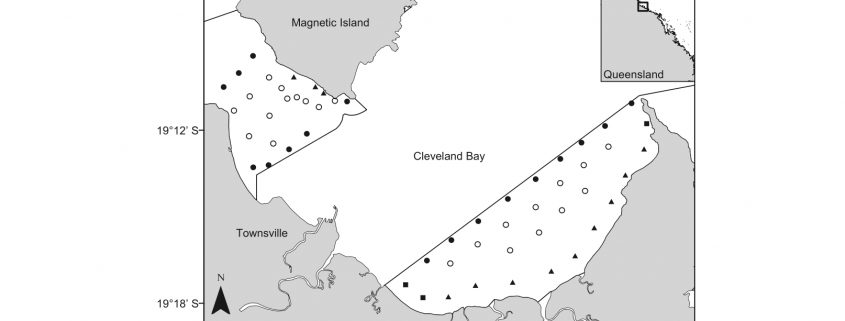Marine Protected Area (MPA) Effectiveness
By: Olivia Wigon, SRC Intern
Marine Protected Areas (MPAs) encompass any and every type of area in the oceans, seas, lakes or estuaries. MPAs have some type of restriction on human behavior and activity in an area with the intention to conserve natural resources in that area. MPAs not only protect animals but the economy through tourism and fishing. Divers and other ocean lovers will travel to see marine protected areas because of the large animals and the amount of life in them which stimulates the local economy. MPAs also help fishermen because the fish have time to grow and reproduce providing fishermen with sustainable amount of large fish to catch when the fish leave the MPA. While there has been an increase in MPAs, there are still challenges in determining the social and economic benefits of them (Edgar et al. 2014). Graham J. Edgar and his team looked at 87 MPAs located all around the world and found that they are most successful when there are 5 key features. The 5 features are well enforced, no take, isolated by deep water or sand, are older than 10 years, and are larger than 100 square kilometers. An effective MPA has twice as many large fish, five times more large fish biomass, and fourteen times more shark biomass than in unprotected areas (Edgar et al. 2014). Unfortunately, Graham J. Edgar and his team found that only 41% of MPAs studied had 3 or more of these key features. It is important to note that each MPA is different and is designed with different circumstances in mind. For example, an MPA may be designed for a specific species in mind, or for a specific time of year.

Globally shark populations are struggling due to over fishing, climate change, and shark finning. Additionally, shark populations take years to recover because they are k-selected species which means they have long life spans, few offspring and late sexual maturity. Humans are also k-selected animals. This has resulting in urgent conservation effort, including establishing marine protected areas in various shark habitats. Many species of sharks are pelagic which means that they travel great distances in the open ocean. Conservation for pelagic species is difficult because they are constantly moving so they will be protected in one area but as soon as they swim out of the MPA it is at risk again. In order to understand how MPAs protect sharks Danielle M. Knip and her team used acoustic tags and receivers around the Great Barrier Reef Marine Park in Australia. Both juvenile pigeye and adult spot-tail sharks were given acoustic tags. The juvenile pigeye sharks were found to spend more time in the MPAs during the summer and the adult spot-tails spent more time there in the winter (Knip et al. 2012). The MPAs in this study were shown to be effective because they protect multiple species, at various life stages, during various times of the year. Knips team also looked at how often sharks were leaving the marine protected area and where they were exiting and entering the MPAs. While the MPAs studied were not specifically designed for shark conservation they are aiding in the efforts to protect shark populations.

Conrad W. Speed and his team looked at how long it takes a shark population to rebound after exploitation and how the establishment of MPAs helps the recovery process (Speed et al. 2018). The team used baited remote underwater video stations (BRUVS) which are essentially a camera attached to a bait box which allows researchers to see what animals live in the area and how many of them there are. The team collected data both before and after several years of strict MPA enforcement. The MPAs the team looked at were well-managed and were no-take zones which means that nothing could be caught or removed from that area. Speed and the team saw a significant increase in apex species, and reef shark populations. Similar results were found amongst all the MPAs that were studied. Overall, the data shows that when marine protected areas are established and enforced for a significant amount they are effective in regards to an increase in fish biomass and an increase in shark populations. As the environmental movement grows there is becoming a greater demand for the creation of new marine protected areas and better management of those already established.

Work Cited:
Edgar, Graham J., et al. (2014) “Global Conservation Outcomes Depend on Marine Protected Areas with Five Key Features.” Nature, vol. 506, no. 7487, pp. 216–220., doi:10.1038/nature13022.
Knip, Danielle M., et al. (2012) “Evaluating Marine Protected Areas for the Conservation of Tropical Coastal Sharks.” Biological Conservation, vol. 148, no. 1, pp. 200–209., doi:10.1016/j.biocon.2012.01.008.
Speed, Conrad W., et al. (2018) “Evidence for Rapid Recovery of Shark Populations within a Coral Reef Marine Protected Area.” Biological Conservation, vol. 220, pp. 308–319., doi:10.1016/j.biocon.2018.01.010.



